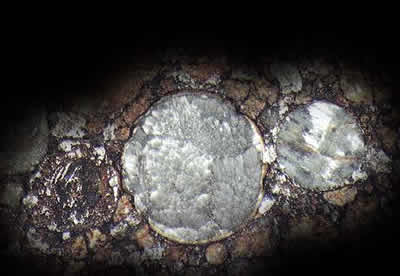Chondrule
A chondrule is a spherical, millimetre sized, silicate inclusion found in a type of meteorite called a chondrite. Embedded in fine-grained interplanetary dust, up to 80% of the meteorite can exist as chondrules.
Made of the minerals olivine and pyroxene (with perhaps smaller amounts of glass, iron and nickel present), chondrules are the oldest objects in the Solar System. Their spherical nature suggests that they were once molten, and it is thought that they solidified very quickly – indicating that the heat source was a sudden, high-energy event. The existence of different types of chondrules further supports this idea, since the different characteristics would require different formation histories. This suggests that whatever formed the chondrules must have occured over a relatively small area in the solar nebula. Mechanisms proposed include: nebular lightning, shock waves in the nebula, energetic outflows from the Sun, and melting via impacts.
Study Astronomy Online at Swinburne University
All material is © Swinburne University of Technology except where indicated.


